 Marina de Guerra del Perú
Marina de Guerra del Perú
2 cruisers, 2 destroyers, 4 submarines, 3 gunboats, 30 auxiliaries and small patrol vessels
The Peruvian Navy was the fourth largest in South America when the second world war broke out in 1939. It was just in the process of modernization, with the 1909 destroyer Rodriguez discarded and hulked, and in 1940 the 1881 school cruiser Lima. During the Presidency of Augusto B. Leguía between 1919 and 1930, a Navy Ministry was established and a Navy Aviation Corps in 1920. There were border conflicts with Colombia in 1911 and 1932 and a war with Ecuador in 1941, the Navy being involved with skirmishes in support of the Army. In WW2, Peru remained neutral and fieleded two modernized light cruisers (the Almirante Grau class, British built), two destroyers (The guise class, Russian built, ex-Estonian), four submarines (US built R1 class), and three riverine gunboats, two recent, one old. Peru did not declare war on the Axis until June 1945, and the navy took on patrol missions against possible Imperial Japanese Navy interference from early 1942 up to mid-1945.
History: From 1860
Always behind Chile, Brazil and Argentina, Peru yet was the first country in South America to have an ironclad, the Huascar. But the pacific war ended in 1883 with Peru defeated and much poorer. In 1906, the Peruvian fleet still had the cruiser Lima from 1881, the river gunboat America, old coastal monitor Atahualpa, cadet schoolship Apurimac.
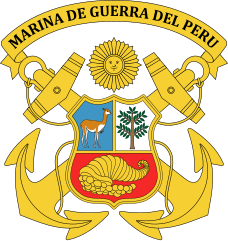 Prior to WW1 a modest naval plan call for a few purchased in UK (two light cruisers, the Almirante Grau class) and two submarines built in France (the Ferre class). In 1912, France was also contacted for a purchase of her former armoured cruiser Dupuy de Lome, officially transferred as Commandante Aguirre with small crew transferred in France for the commissioning, but realizing her poor state, it was decided instead to sell her to a Begian Tranport company instead, she she left port, done deal. She was converted as a merchant ship (a new career which ended in 1920). Instead, the French naval mission in Peru managed to sell the destroyer Rodriguez (ex-Actée).
Prior to WW1 a modest naval plan call for a few purchased in UK (two light cruisers, the Almirante Grau class) and two submarines built in France (the Ferre class). In 1912, France was also contacted for a purchase of her former armoured cruiser Dupuy de Lome, officially transferred as Commandante Aguirre with small crew transferred in France for the commissioning, but realizing her poor state, it was decided instead to sell her to a Begian Tranport company instead, she she left port, done deal. She was converted as a merchant ship (a new career which ended in 1920). Instead, the French naval mission in Peru managed to sell the destroyer Rodriguez (ex-Actée).
Peru was neutral in 1914 but still sent ships to escort of merchant convoys, loosing one of its own civilian ships in 1917, for a small commercial fleet of 40 tall ships and 10 steamers. Only by June 1918, Peru declared war on Germany. The vice-admiral in charge at the time asked for all military ships to be repainted in greyish-brown instead of neutral grey or blue-grey.
The Peruvian Navy in the interwar


BAP Almirante Villar in 1934, commencing service
For the Peruvian Navy, the period 1922-46 was one of continuing border disputes, centred mostly in the Amazon Basin. In 1933 a struggle with Colombia was renewed, last having flared up in 1910. The old cruiser Lima, along with destroyer Rodriguez, was rushed from Callao, through the Panama Canal, and up the Amazon. The destroyers Guise and Villar were purchased from Estonia and hurried directly to the Amazon. To support this makeshift river flotilla, the Peruvian flagship Almirante Grau and two ‘R’ class submaràines were sent to Belem do Para, Brazil, to control the mouth of the Amazon. Learning that Colombia had purchased two Portuguese destroyers, Guise and Villar were despatched to the Caribbean to patrol the Colombian coast, but they failed to intercept their prey. The situation stabilised, and the fleet was withdrawn to Callao and Iquitos. In 1941 the Peruvian Navy had a similar confrontation with Ecuador.
Administratively, the Peruvian Navy was much influenced by US naval missions at this time. North Americans dominated fleet commands from 1920 until 1933 and, toa much lesser extent, from 1937 to 1946. During the early period, Americans held key positions such as Chief of Naval General Staff; Director, Naval Academy; Commander, Naval Station; Chief of Staff, Naval Squadron, and Director of Administration. In 1924 an American was even commander of Peruvian forces afloat, flying his flag on board Almirante Grau.
Ship acquisitions were very modest. The War of the Pacific (1879-83) had devastated Peru, and the economic repercussions extended through the 1922-46 period. Submarines were the only first class warships purchased while peu dis not developed a local naval industry.
The 1932-33 Colombian-Peruvian War
Not to be confused with the Gran Colombian-Peruvian War, this Border conflict between Peru and Colombia erupted over the territory between the Putumayo and Caquetá rivers which had been ceded to Colombia in the Salomón-Lozano Treaty under Augusto Leguía in 1933. Southeast the Amazonian Trapezium the port of Leticia on the Amazon River became the center of a major incident. In the San Miguel-Sucumbíos triangle was ceded as an enclave by Colombia to Peru, but Colombian claims between the Putumayo and Napo-Amazonas rivers remained.
The war started on September 1, 1932 and went on until May 25, 1933, notably over the Putumayo River and tributaries. So Peruvian and Colombian riverine vessels were engaged in skirmishes to support inland troops. The war concluded with the signing of the Rio de Janeiro Protocol of 1934, confering Colombian sovereignty over the Amazonian Delta.
In all, Colombian mobilized, 6200 Soldiers, 11 planes versus Peru’s 10 990 troops (irregulars and 8955 soldiers) and its fleet, comprising at the time 1755 sailors, 4 planes, 6 seaplanes.
Casulaties ranges between 97 and 100 mostly from tropical diseases.
The roots went back to the creation of the Viceroyalty of New Granada from 1739 which extended to the Amazon jungle, and became a center of long discord between Peru and Colombia. The Royal Decree of 1802 gave the area jurisdiction of the Viceroyalty of Peru but it was contested after the independent in 1810.
The Peruvian Navy in WW2
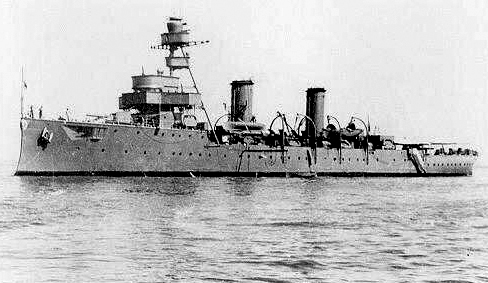
Peruvian cruiser Almirante Grau in 1944
Peru remained neutral but protected its trade on the Pacific for any possible incursion of the IJN. There were treaties with the US also which divided and shared some control areas. Despite of this, neutrality remained in force until June 1945, after much political pressure from the US. No expedition was mounted against the IJN but patrols were maintained.
Before that in 1941, Peru was found on another border war, this time with Ecuador.
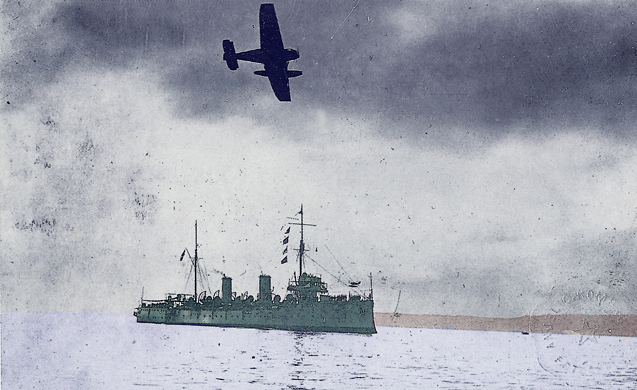
BAP Almirante Grau in 1941
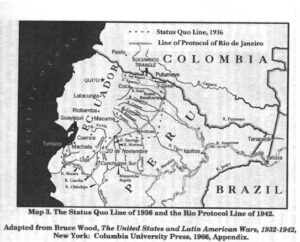 The “Guerra peruano-ecuatoriana” or Peru-Ecuadorean War, “War of ’41” was the result of centuries-old territorial dispute and lack of recoignized borders accepted by both countries, the Peruvian-Ecuadorian War of 1858-1860, happened prior and “False Paquisha” of 1981, and Cenepa War of 1995 erupted after. So the latter is still not solved. The undeclared war began started on July 5, 1941 and as a result until January 29, 1942, when the Protocol of Peace, Friendship and Limits was signed at Rio de Janeiro.
The “Guerra peruano-ecuatoriana” or Peru-Ecuadorean War, “War of ’41” was the result of centuries-old territorial dispute and lack of recoignized borders accepted by both countries, the Peruvian-Ecuadorian War of 1858-1860, happened prior and “False Paquisha” of 1981, and Cenepa War of 1995 erupted after. So the latter is still not solved. The undeclared war began started on July 5, 1941 and as a result until January 29, 1942, when the Protocol of Peace, Friendship and Limits was signed at Rio de Janeiro.
The Peruvian armed forces allegedly crossed in 1936 a provisional border that delimited territories and militarily occupied Ecuadorian provinces of El Oro on the coast, banks of the Jubones River, militarily occupying its capital Machala and other cities such as Puerto Bolívar, Santa Rosa and Pasaje; and the Peruvian Navy exercising a maritime blockade in the Jambelí Channel and the Gulf of Guayaquil, to prevent reinforcement of troops and supplies from Puerto Bolívar, Sierra (Loja province), and Oriente (Napo Pastaza, Santiago Zamora).
According to Ecuador, Peru invaded its territory but it could not repel the invasion as being poorly armed and without resources, added to a difficult internal political situation. According to Peru, it was Ecuador who violated the status quo of 1936 when Ecuadorian forces attacked various Peruvian posts along the border. Both navies took part, alongside apotential 5,214 Ecuadorian soldiers and 8 guns, whereas Peru could muster 9n386 soldiers, 12 tanks, 24 guns and its fleet. The Peruvian fleet played a little part however.
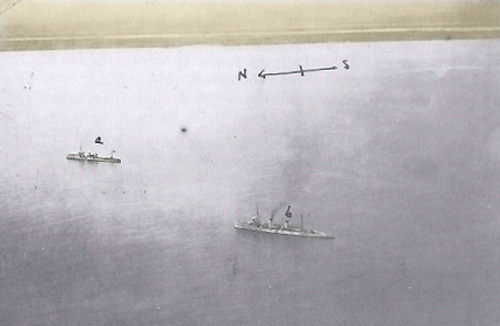
The Peruvian Navy blockade of the Ecuadorian coast in 1941
The Peruvian Marines (1920)
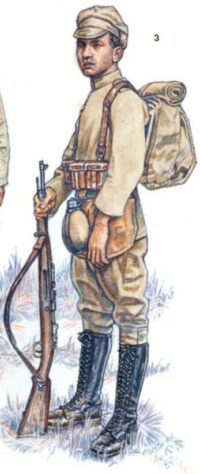 The Marines existed since 1821 but they received an update on 2 February 1919 when the Battalion was organized into two companies of riflemen, one section of machine gunners, another section of servicemen commanded by corvette captain Héctor Mercado. The Peruvian Navy was tasked of protected in WW2 the oil port of Talara and patrolled the continent and Panama Canal, with armed auxiliary transport carrying Marines ready to intervene if needed. On 9 June 1943, President Manuel Prado decreed the creation of the Infantería de Marina as part of the Naval Coast Defense Force but it was realized postwar. Illustration: Peruvian Marine in 1933.
The Marines existed since 1821 but they received an update on 2 February 1919 when the Battalion was organized into two companies of riflemen, one section of machine gunners, another section of servicemen commanded by corvette captain Héctor Mercado. The Peruvian Navy was tasked of protected in WW2 the oil port of Talara and patrolled the continent and Panama Canal, with armed auxiliary transport carrying Marines ready to intervene if needed. On 9 June 1943, President Manuel Prado decreed the creation of the Infantería de Marina as part of the Naval Coast Defense Force but it was realized postwar. Illustration: Peruvian Marine in 1933.
The Peruvian Naval Air Corp (1920)
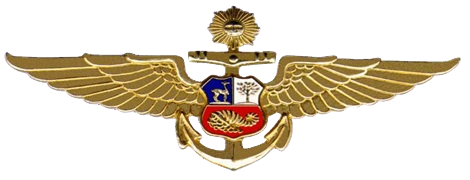
Peru was one of the rare countries with a constituted, independent naval air force but only for a short time. The Fuerza de Aviación Naval indeed was the air branch of the Peruvian Navy originally formed in 1919 as the Naval Aviators Corps (Cuerpo de Aviadores Navales). One of its first acquisition was the torpedo bomber Keystone I-R-4 that flew over the Amazon in 1927. This made the Peruvian Naval Aviation one of the pioneers in Latin America. The decree of December 9, 1919, was intended to strengthen national sovereignty by integrating aircraft to operate with ships and submarines. On January 26, 1920 a law legal created the Naval Aviators Corps, with Juan Leguía Swayne named as its Head with the rank of Lieutenant Commander.
Later, the American Aeronaval Mission established in Peru from 1924 to 1930 consolidated Naval Aviation by professionalizing its activities, and the creation of naval air stations San Ramón and Itaya to link Lima and Iquitos through regular flights. The Navy was able to connect remote area of the country with the capital early on. On one of these NAS was also created a squadron of torpedo bombers, provided the Blackburn Kangaroo R.T.1, before the Keystone bombers were acquired. There were fighter protection provided by Boeing PW-9 (FB.5) as well, and two reconnaissance floatplanes, the Vought FU-1.
Unfortunately, the Cuerpo de Aviadores Navales was merged in 1932 with the Peruvian Army Aviation after inter service rivalry squabbles. The service was recreated on July 3, 1963. See the cold war section for more.
Nomenclature of Peruvian warships
 Almirante Grau class cruisers (1906)
Almirante Grau class cruisers (1906)

The flagship of the Peruvian Navy was from 1906 to 1958, the cruiser Almirante Grau. Light cruiser by displacement, she was a far cry from the dreadnoughts showcased by Brazil, Argentina and Chile. Ordered in Britain in 1904 as part of an ambitious naval plan, Almirante Grau was the lead ship of the class of two cruisers with her sister Colonel Bolognesi to be ordered at Armstrong-Elswick in 1905, launched in March and September 1906 respectively. Most powerful ships of the Peruvian Navy for half a century the first was named after war hero Miguel Grau which fought the Chilean Navy in 1879 and Coronel Francisco Bolognesi Cervantes died at the battle of Arica in 1880. Apart subtle differences in design (Bolognesi had no poop deck) both were 3,100 tons standard in displacement and capable of 24.64 knots.
On construction they had been designed as close to British scouts such as the Sentinel class presented by the builder and they had different hulls, two funnels instead of three as well as a much stronger armament. Almirante Grau as flag ship was given additional accommodation spaces located in her poop and ended 20t heavier in displacement. On trials, Grau reached 24.64kts on forced heat.
Full specs:
Displacement: 3,100t standard, 4,877t fully loaded
Dimensions: 112.8 pp (115.8m oa) x 12.3m beam, 4.30m draught
Protection: 1.8-in (38mm) belt amidships and armoured deck. CT, shields 3-in (76mm) armour.
Armament: Two shielded 6-in/50 guns (152 mm) fore and aft decks, eight shielded 3-in guns (76 mm) on the lower deck sponsons alternated with6 pdr, four were mounted amidship, two on each side of the forward bridge superstructure. Also one 1-pdr saluting gun, two 18 in (457 mm) submarine torpedo tubes.
Propulsion: Two shafts, 2 yarrow VTE 4-cyl. steam engines, 10 Yarrow watertube boilers for 14,000 hp, 24 knots, 500 tons coal for 3,276 nm range at 10 knots.
Upgrades:
In 1923-1925 they had their boilers converted to oil fuel (500t oil, 3700 nm at 10 kts) whereas two 3-in/40 were removed. In 1933-1935 their boilers were replaced altogether by 8 new Yarrow models but they still were rated at 14,000 hp for 23.5kts and same range. In 1936 they were partially modernized, with their main mast removed, two more 3-in/40 and all six 6-pdr and single 1-pdr (37mm/20) removed but two 3-in/40 of Japanese origin installed (with high elevation mounts) as well as two twin 13.2mm/76 heavy machine guns AA mounts.
In 1942-1944 the foremast was replaced by tripod and the superstructures rebuilt, larger with a better fire control. Their 13.2 mm HMGs and torpedo tubes were removed and instead seven Brownonh M2HB 0.5-in/90 heavy machine guns installed as a DCT, and two DCR for ASW purposes.
History:
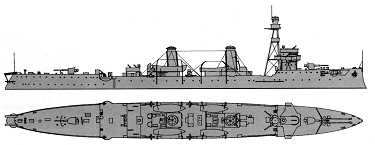 Both escorted merchant ships in WW1, based from Callao, Almirante Grau doubling a depot ship for submarines. In 1925 they were refitted, and in 1932, they went at war against Colombia over territory in the Amazon rainforest. In May 1933, Almirante Grau escorted by two submarines sent via the Panama Canal to the Amazon River in order to support operations there but the war ended before she arrived. She returned to the Pacific and had another refit in 1934, being rearmed later by Japanese AA guns.
Both escorted merchant ships in WW1, based from Callao, Almirante Grau doubling a depot ship for submarines. In 1925 they were refitted, and in 1932, they went at war against Colombia over territory in the Amazon rainforest. In May 1933, Almirante Grau escorted by two submarines sent via the Panama Canal to the Amazon River in order to support operations there but the war ended before she arrived. She returned to the Pacific and had another refit in 1934, being rearmed later by Japanese AA guns.
From July 1941 to January 1942, they took part in a blockade of the Gulf of Guayaquil as the Ecuadorian–Peruvian War rage on. They were again modernized, and when Peru declared war on Germany in 1944, they spent the rest of the war in coastal patrols. After 1946 they acted as training ships, stationary hulks in 1950 before being stricken both on 24 June 1958, sold for BU.
 Guise class destroyers (1933)
Guise class destroyers (1933)

Ex-Estonian destroyers purchased for 410.000$ each in 1933 by Peru, already the 1915 Russian Iziaslav/Avtroil class style Russian destroyers. Renamed Guise (ex-Lennuk) and Villar (ex-Vambola). Both made quite a trip from the Baltic to the Peruvian Amazon and served out there for their entire careers until Guise was discarded in 1947 and Villar in 1954. They were sometimes incorrectly referred to as Almirante Guise and Almirante Villar by some authors. They were extremely valuable ship, faster than the cruisers, with powerful guns, torpedo armament, and acting as minelayers if needed.
In 1941 Villar and Giuse received three 20mm/65 Breda 1939 AA guns. Villar took part in the revolution in October 1948 and her hull was seriously damaged as well as her steam coolers, in 1952 she ended in the naval school as training hulk. Her sister Guise was decommissioned in November 1947, she was not BU and instead left to rust in the very humid envornment off San Lorenzo naval base, remnants still visible today.
Specs
Dimensions: 105 x 9,53 x 3,60 m, displacement 1,785 tonnes
Propulsion: 2 shafts Brown-Boveri, 4 Vulcan/Normand boilers, 24,000 kW (32,000 hp), 30 kts (56 km/h) RA 2400 nm (3900 km)/15 kts
Armament: 5 x102 mm/60 m1911, 2x 20 mm AA, 2 LMGs, 3×3 457 mm TTs, 80 mines
 Islay (R) class submarines (1928)
Islay (R) class submarines (1928)
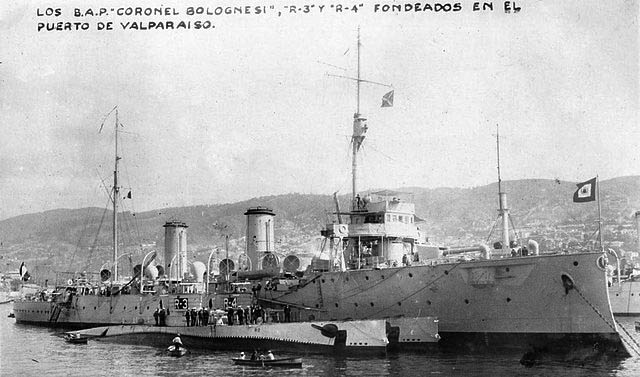
R3, R4 in Valparaiso alongside their tender, BAP Bolognesi.
Commissioned 12.12.26 (RI, R2) and in 1928 (R3, R4). RS and R6 were projected in 1926 but never funded. The first two submarines were ordered 11.4.1924, the other two on 11.10.1926 at 6.200.000$ total. 2 more were planned but not budgeted. These were medium saddle-tank-hull submarines of Holland design, very close in design to the US R class. They all received major refits 1935-36 and 1955-56. The boats were renamed Islay, Casma, Pacocha and Arica, respectively in 1957. R1 was launched 12.7.1926, R2 on 29.3.1926, R3 on 21.4.1928 and R4 on 10.5.1928, all Discarded 1960.
Specs
Displacement: 576t/755t
Dimensions: 178ft 6in pp, 186ft 3in oa X 17ft 6in x 15ft 54.41, 56.77 X 5.33 x 4.57m
Machinery: 2-shaft Nelseco diesels plus electric motors, 800bhp/1000hp for 14.5kts/9.5kts
Armament: 4x 21in TT (bow), 1—3in
Complement: 30
 Peruvian gunboats
Peruvian gunboats
LORETA class river gunboats (1934): Amazonas, Loreta were built by Electric Boat and were modernized in 1960 still active in 1980 at Iquitos.
Displacement: 250t Dimensions: 153ft x 22ft x 4ft 6in 46.33 x 6.71 X 1.37m
Machinery: 2 diesels, 700bhp = 15kts Armament: 4-3in, 2-20mm, 2 MG
River gunboat America (1904): 240t, in 1980 still lied at Iquitos. Converted as museum ship.
Peru also operated numerous small river craft in 1922.
Read More/src
Books
Conways all the world’s fighting ships 1860-1905, 1906-1921, 1922-47
Moore, John (1990). Jane’s Fighting Ships of World War I. London: Studio.
“New Peruvian Warships”. Journal of the American Society of Naval Engineers. XIX (2) May 1907.
Whitley, M. J. (1999). Cruisers of World War Two: An International Encyclopedia. London: Brockhamton Press.
Fisher, Edward C. Jr. (1975). “50 Years of Service: The Story of Peru’s Coronel Bolognesi and Almirante Grau”. Warship International. XII (4)
Links
https://www.gob.pe/marina/
https://www.escuelanaval.edu.pe/
https://en.wikipedia.org/wiki/List_of_Peruvian_Navy_ships
https://www.navypedia.org/ships/peru/per_index.htm
https://es.wikipedia.org/wiki/Marina_de_Guerra_del_Per%C3%BA
marina.mil.pe
https://archive.org/details/journalamerican01engigoog/page/581/mode/2up?view=theater


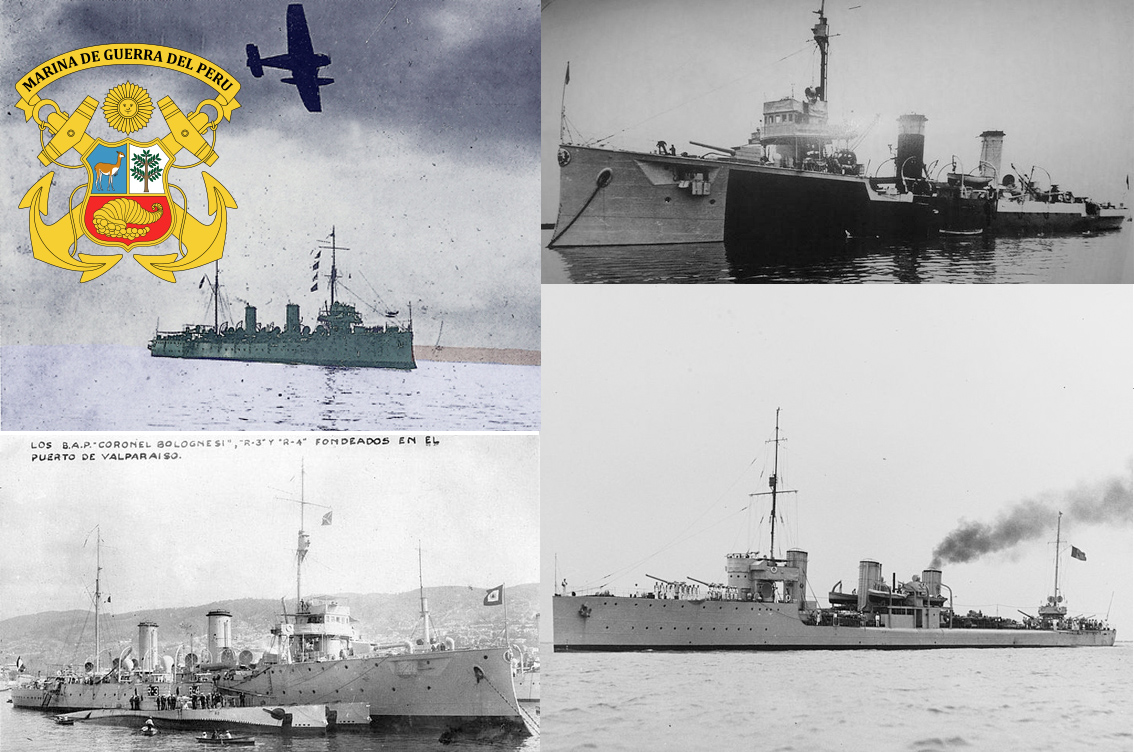
 Latest Facebook Entry -
Latest Facebook Entry -  X(Tweeter) Naval Encyclopedia's deck archive
X(Tweeter) Naval Encyclopedia's deck archive Instagram (@navalencyc)
Instagram (@navalencyc)





 French Navy
French Navy Royal Navy
Royal Navy Russian Navy
Russian Navy Armada Espanola
Armada Espanola Austrian Navy
Austrian Navy K.u.K. Kriegsmarine
K.u.K. Kriegsmarine Dansk Marine
Dansk Marine Nautiko Hellenon
Nautiko Hellenon Koninklije Marine 1870
Koninklije Marine 1870 Marinha do Brasil
Marinha do Brasil Osmanlı Donanması
Osmanlı Donanması Marina Do Peru
Marina Do Peru Marinha do Portugal
Marinha do Portugal Regia Marina 1870
Regia Marina 1870 Nihhon Kaigun 1870
Nihhon Kaigun 1870 Preußische Marine 1870
Preußische Marine 1870 Russkiy Flot 1870
Russkiy Flot 1870 Svenska marinen
Svenska marinen Søværnet
Søværnet Union Navy
Union Navy Confederate Navy
Confederate Navy Armada de Argentina
Armada de Argentina Imperial Chinese Navy
Imperial Chinese Navy Marinha do Portugal
Marinha do Portugal Mexico
Mexico Kaiserliche Marine
Kaiserliche Marine 1898 US Navy
1898 US Navy Sovietskiy Flot
Sovietskiy Flot Royal Canadian Navy
Royal Canadian Navy Royal Australian Navy
Royal Australian Navy RNZN Fleet
RNZN Fleet Chinese Navy 1937
Chinese Navy 1937 Kriegsmarine
Kriegsmarine Chilean Navy
Chilean Navy Danish Navy
Danish Navy Finnish Navy
Finnish Navy Hellenic Navy
Hellenic Navy Polish Navy
Polish Navy Romanian Navy
Romanian Navy Turkish Navy
Turkish Navy Royal Yugoslav Navy
Royal Yugoslav Navy Royal Thai Navy
Royal Thai Navy Minor Navies
Minor Navies Albania
Albania Austria
Austria Belgium
Belgium Columbia
Columbia Costa Rica
Costa Rica Cuba
Cuba Czechoslovakia
Czechoslovakia Dominican Republic
Dominican Republic Haiti
Haiti Hungary
Hungary Honduras
Honduras Estonia
Estonia Iceland
Iceland Eire
Eire Equador
Equador Iran
Iran Iraq
Iraq Latvia
Latvia Liberia
Liberia Lithuania
Lithuania Mandchukuo
Mandchukuo Morocco
Morocco Nicaragua
Nicaragua Persia
Persia San Salvador
San Salvador Sarawak
Sarawak Uruguay
Uruguay Venezuela
Venezuela Zanzibar
Zanzibar Warsaw Pact Navies
Warsaw Pact Navies Bulgaria
Bulgaria Hungary
Hungary

 Bundesmarine
Bundesmarine Dutch Navy
Dutch Navy Hellenic Navy
Hellenic Navy Marina Militare
Marina Militare Yugoslav Navy
Yugoslav Navy Chinese Navy
Chinese Navy Indian Navy
Indian Navy Indonesian Navy
Indonesian Navy JMSDF
JMSDF North Korean Navy
North Korean Navy Pakistani Navy
Pakistani Navy Philippines Navy
Philippines Navy ROKN
ROKN Rep. of Singapore Navy
Rep. of Singapore Navy Taiwanese Navy
Taiwanese Navy IDF Navy
IDF Navy Saudi Navy
Saudi Navy Royal New Zealand Navy
Royal New Zealand Navy Egyptian Navy
Egyptian Navy South African Navy
South African Navy






























 Ukrainian Navy
Ukrainian Navy dbodesign
dbodesign